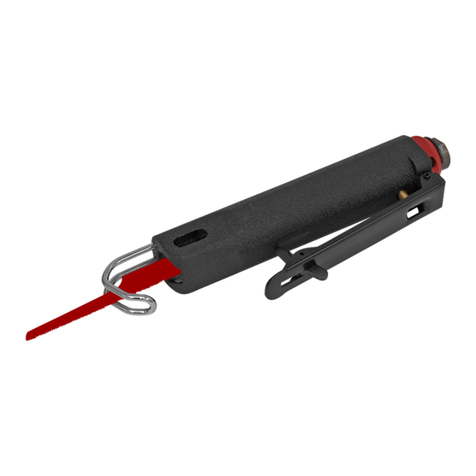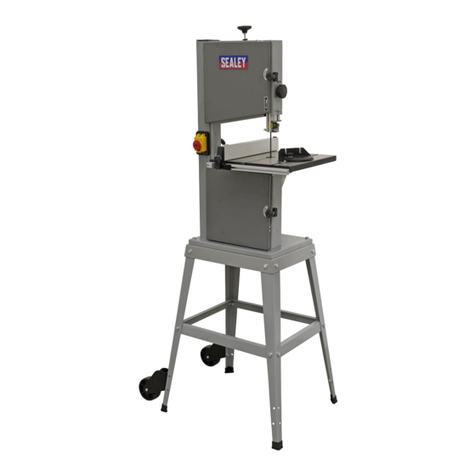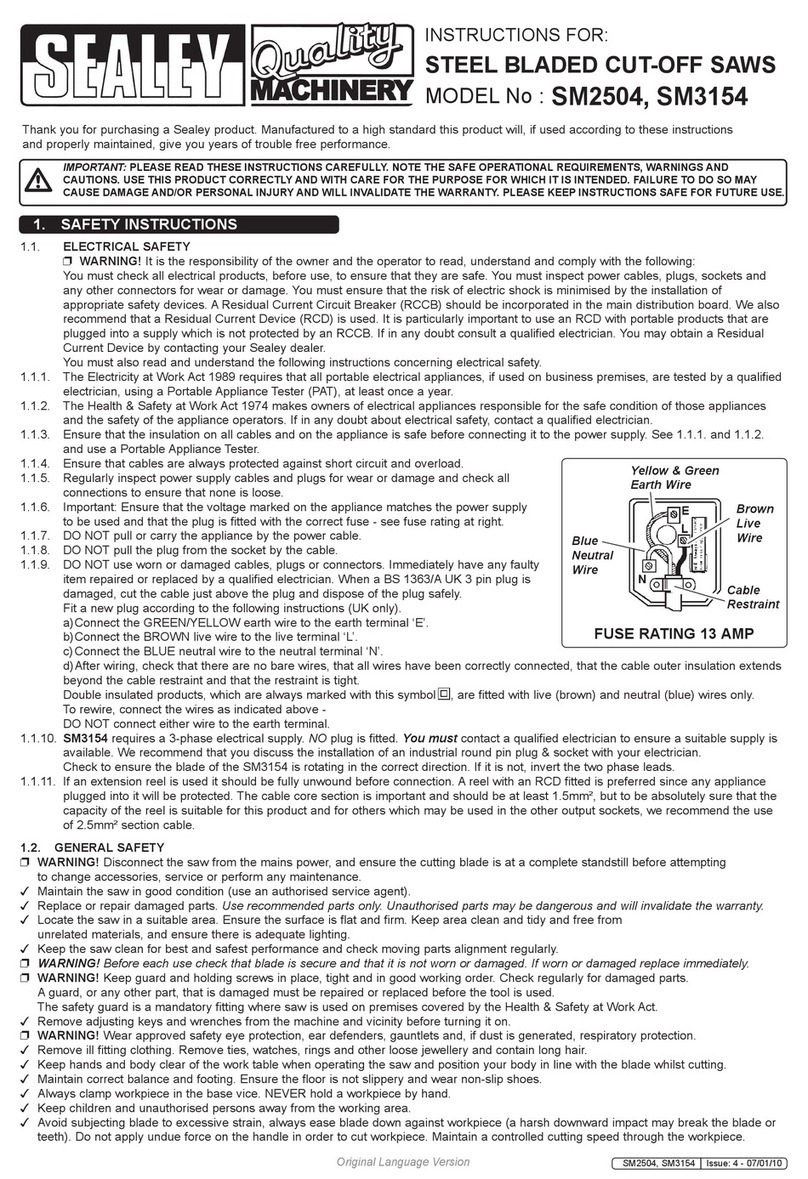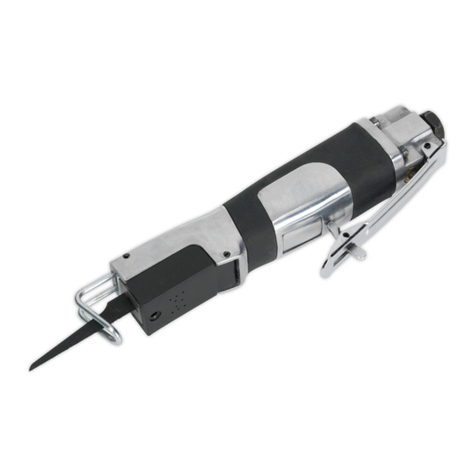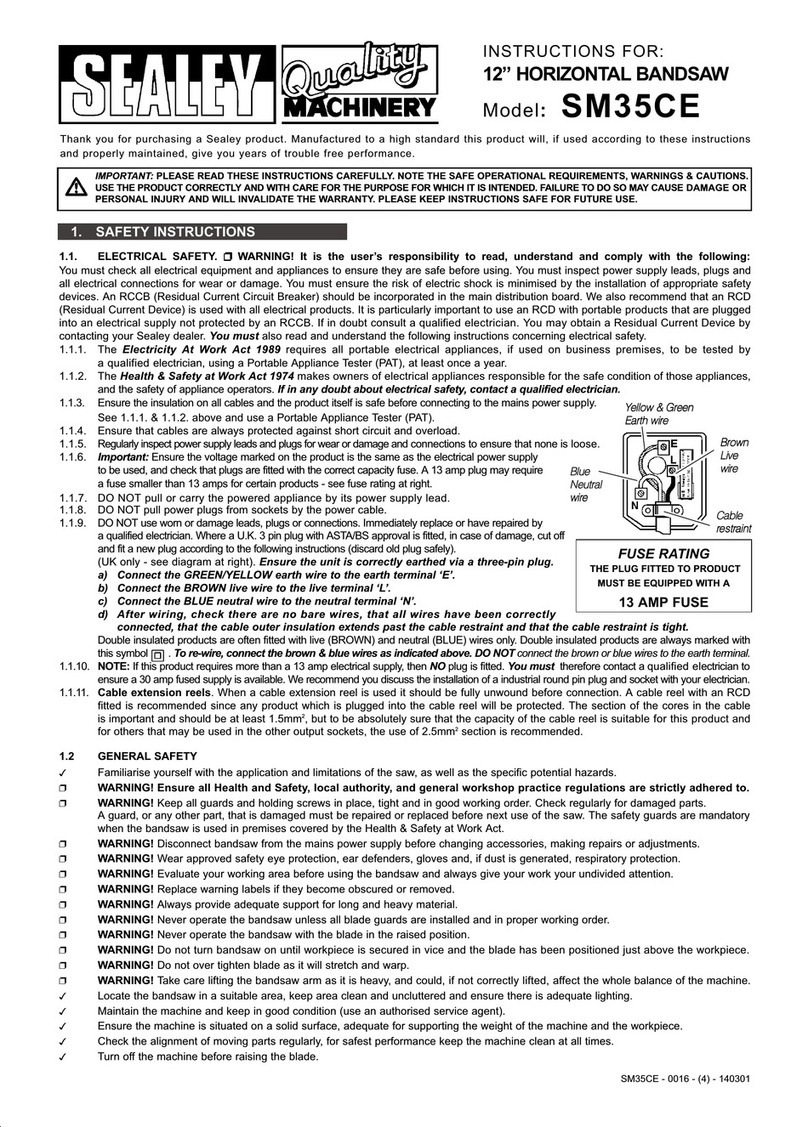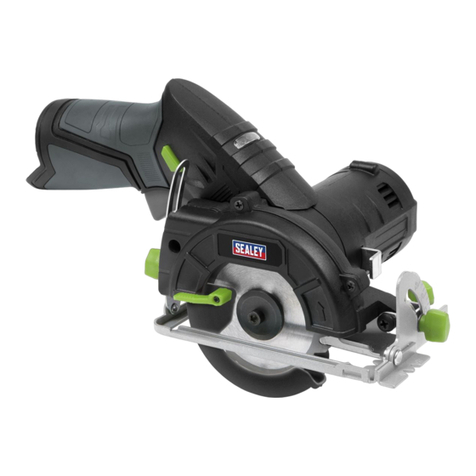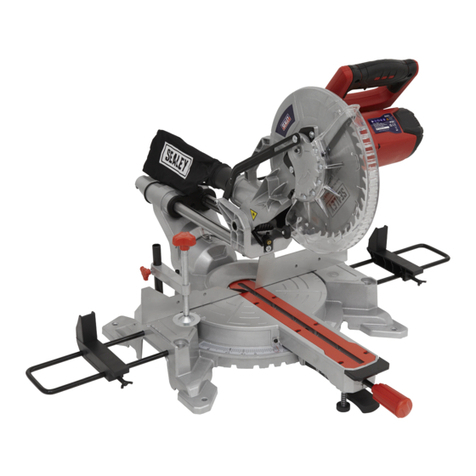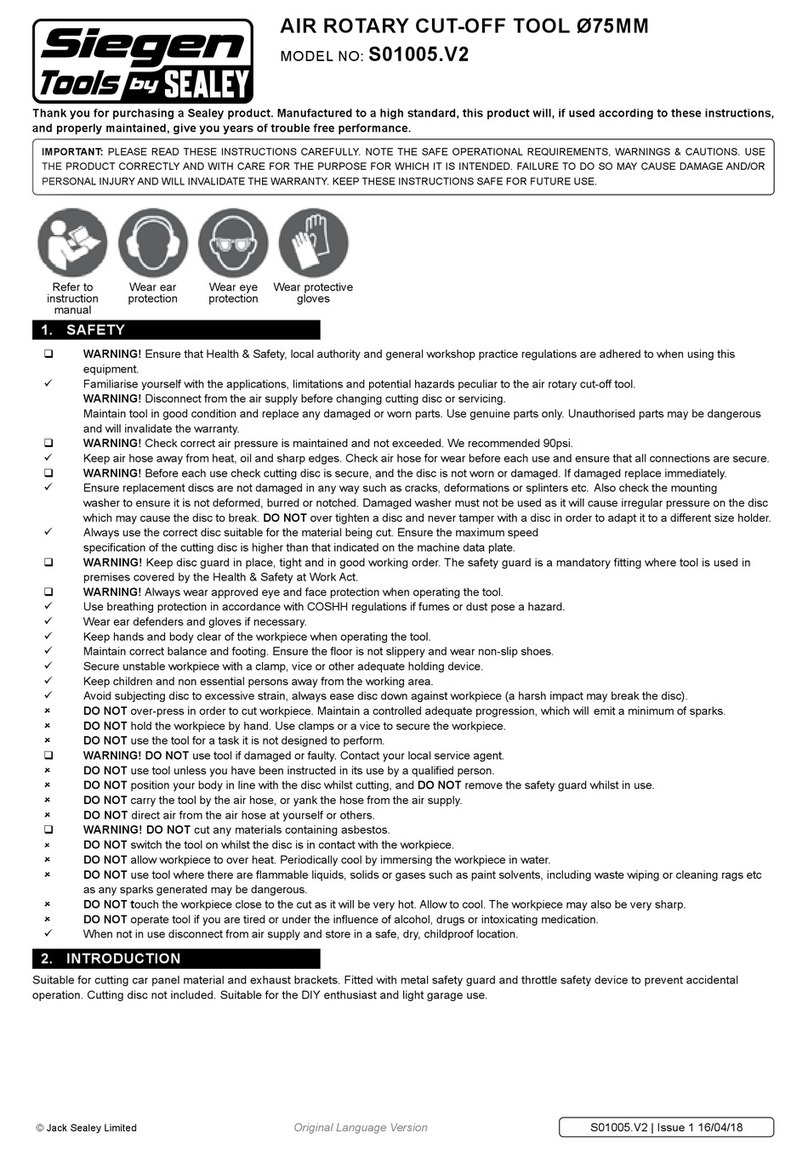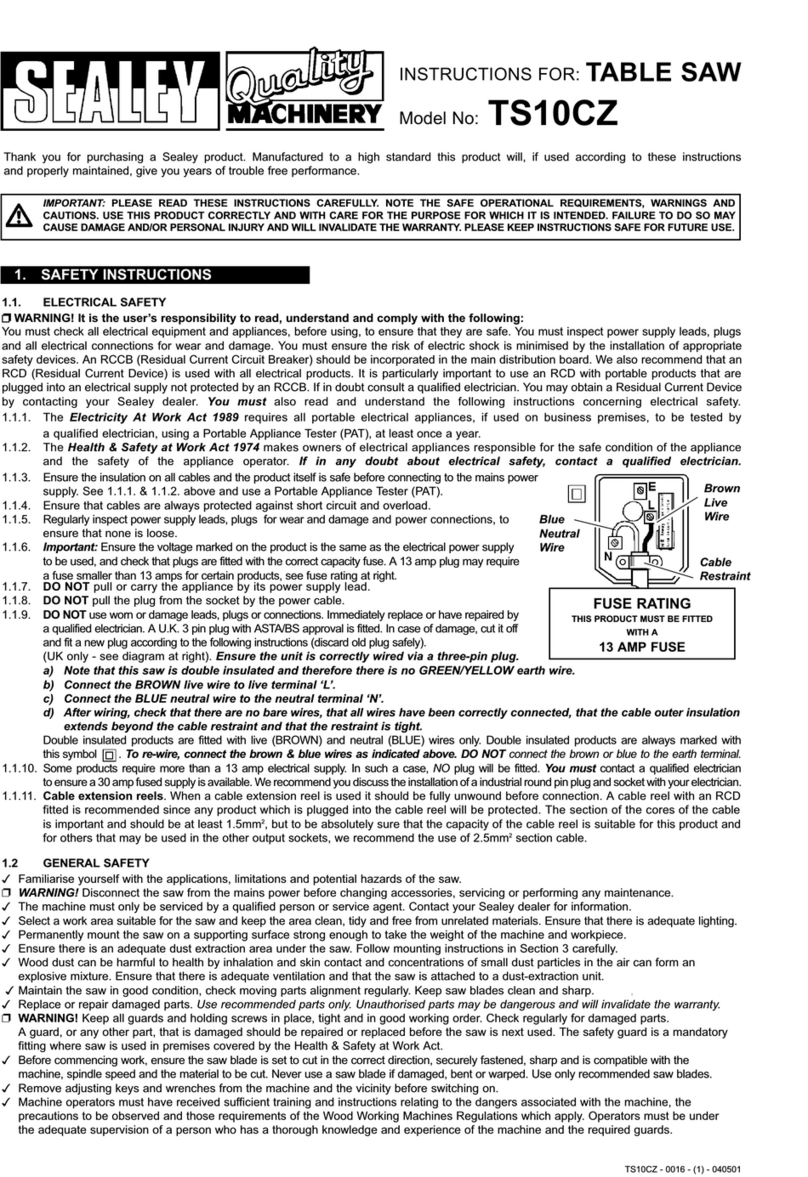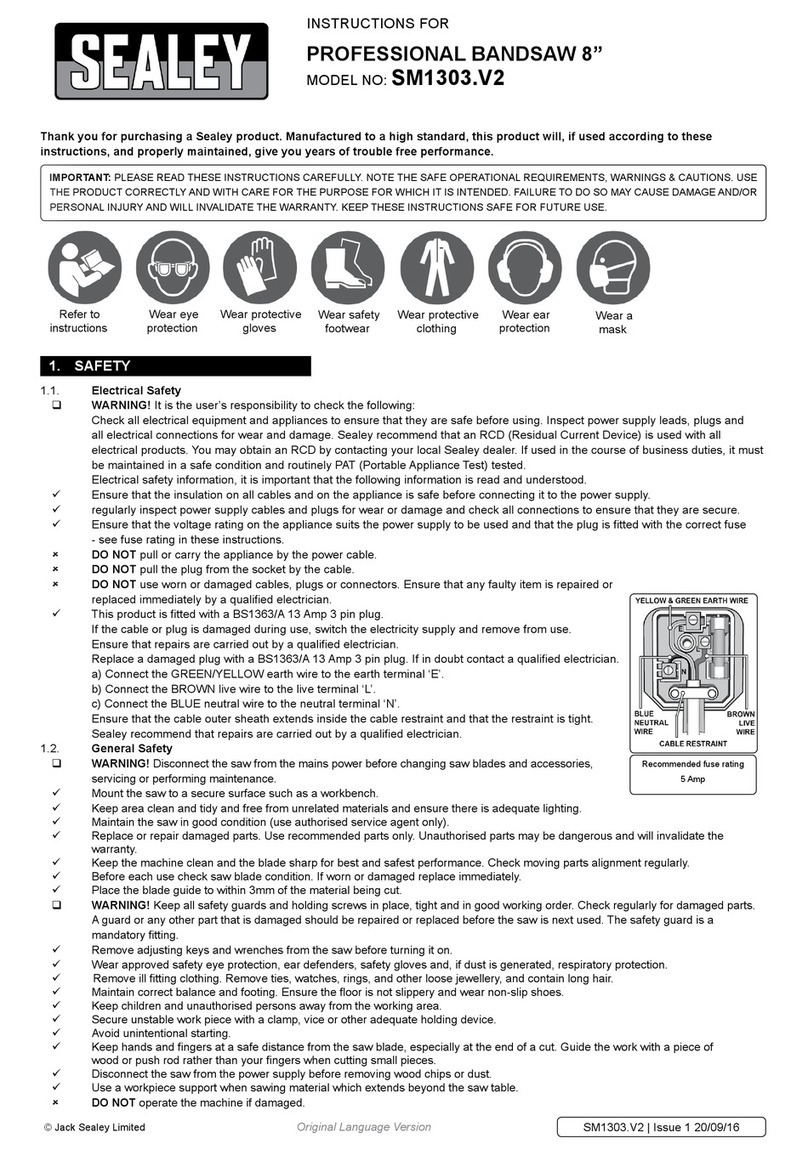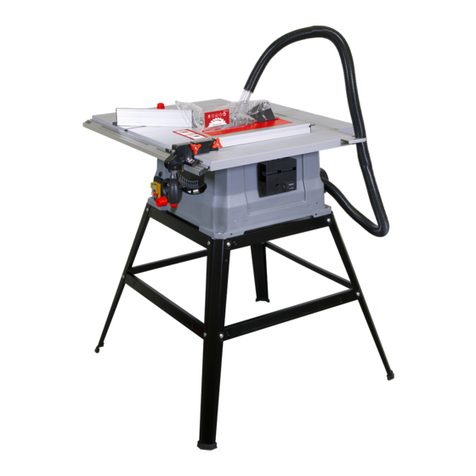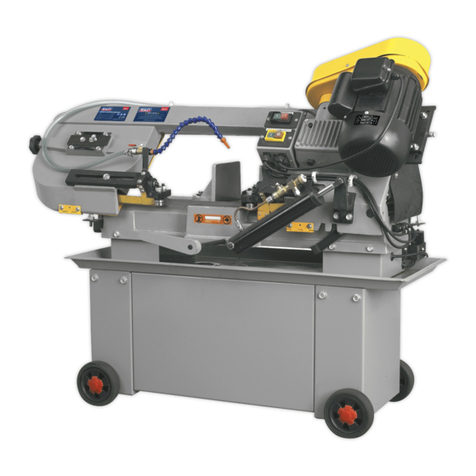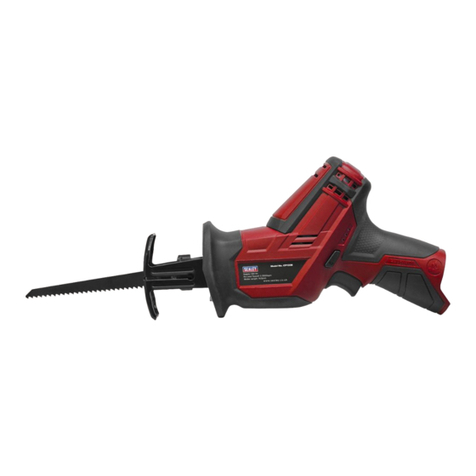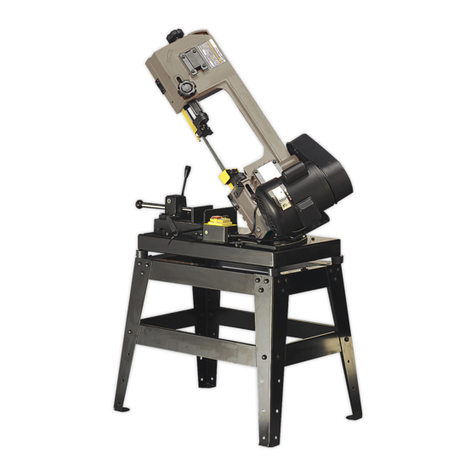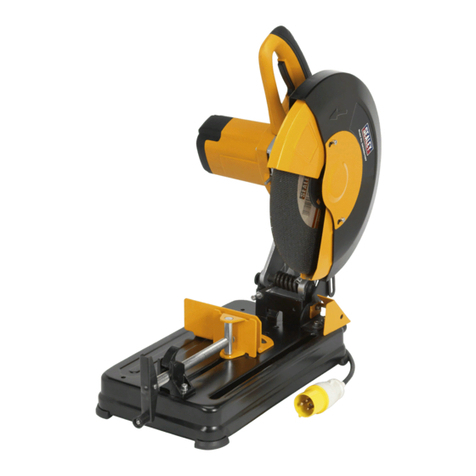
INSTRUCTIONS FOR:
STEEL BLADED CUT-OFF SAWS
Models: SM225, SM250 & SM275
Thank you for purchasing a Sealey product. Manufactured to a high standard this product will, if used according to these instructions
and properly maintained, give you years of trouble free performance.
1. SAFETY INSTRUCTIONS
The use of symbols in this document is to attract your attention to possible danger. The symbols and warnings themselves do not eliminate any danger, nor are they substitutes for proper
accident prevention measures.
IMPORTANT: PLEASE READ THESE INSTRUCTIONS CAREFULLY. NOTE THE SAFE OPERATIONAL REQUIREMENTS, WARNINGS AND
CAUTIONS. USE THIS PRODUCT CORRECTLY AND WITH CARE FOR THE PURPOSE FOR WHICH IT IS INTENDED. FAILURE TO DO SO MAY
CAUSE DAMAGE OR PERSONAL INJURY AND WILL INVALIDATE THE WARRANTY. PLEASE KEEP INSTRUCTIONS SAFE FOR FUTURE USE.
1.2 GENERAL SAFETY
pWARNING! Disconnect the saw from the mains power, and ensure the cutting blade is at a complete standstill before attempting
to change accessories, service or perform any maintenance.
3Maintain the saw in good condition (use an authorised service agent).
3Replace or repair damaged parts. Use recommended parts only. Non authorised parts may be dangerous and will invalidate the warranty.
3Locate the saw in an adequate working area for its function. Ensure the surface is flat and firm. Keep area clean and tidy and free from
unrelated materials, and ensure there is adequate lighting.
3Keep the saw clean for best and safest performance and check moving parts alignment regularly.
pWARNING! Before each use check that blade is secure and that it is not worn or damaged. If worn or damaged replace immediately.
pWARNING! Keep guard and holding screws in place, tight and in good working order. Check regularly for damaged parts.
A guard, or any other part, that is damaged should be replaced with a new one, to ensure that it operates properly and performs its intended
function, before the tool is used. The safety guard is a mandatory fitting where saw is used in premises covered by the Health & Safety at
Work Act.
3Remove adjusting keys and wrenches from the machine and its vicinity before turning it on.
pWARNING! Wear approved safety eye protection, ear defenders, and gauntlets, and, if dust is generated, respiratory protection.
3Remove ill fitting clothing. Remove ties, watches, rings and other loose jewellery and contain long hair.
3Keep hands and body clear of the work table when operating the saw and position your body in line with the blade whilst cutting.
3Maintain correct balance and footing. Ensure the floor is not slippery and wear non-slip shoes.
3Always clamp workpiece in the base vice. NEVER hold a work piece by hand.
3Keep children and unauthorised persons away from the working area.
3Avoid subjecting blade to excessive strain, always ease blade down against workpiece (a harsh downward impact may break the blade or
teeth). Do not apply undue force on the handle in order to cut workpiece. Maintain a controlled cutting speed through the workpiece.
pWARNING! DO NOT switch the saw on whilst the blade is in contact with the workpiece. Bring the rotating blade to the workpiece.
and avoid un-intentional starting of the saw.
7DO NOT hold the workpiece by hand. Use base vice to secure the workpiece. SM225, 250 & 275 - (2) - 051102
1.1. ELECTRICAL SAFETY. p
p
WARNING! It is the users responsibility to read, understand and comply with the following:
You must check all electrical equipment and appliances to ensure they are safe before using. You must inspect power supply leads, plugs
and all electrical connections for wear and damage. You must ensure the risk of electric shock is minimised by the installation of appropriate
safety devices. An RCCB (Residual Current Circuit Breaker) should be incorporated in the main distribution board. We also recommend that
an RCD (Residual Current Device) is used with all electrical products. It is particularly important to use an RCD together with portable products
that are plugged into an electrical supply not protected by an RCCB. If in doubt consult a professional electrician. You may obtain a Residual
Current Device by contacting your Sealey dealer. You must also read and understand the following instructions concerning electrical safety.
1.1.1. The Electricity At Work Act 1989 requires all portable electrical appliances, if used on a business premises, to be tested by a qualified
Electrician at least once a year by using a Portable Appliance Tester (PAT).
1.1.2. The Health & Safety at Work Act 1974 makes owners of electrical appliances responsible for the safe condition of the appliance,
and the safety of the appliance operator. If in any doubt about electrical safety, contact a qualified electrician.
1.1.3. Ensure the insulation on all cables and the product itself is safe before connecting to the mains power supply.
See 1.1.1. & 1.1.2. above and use a Portable Appliance Tester (PAT).
1.1.4. Ensure that cables are always protected against short circuit and overload.
1.1.5. Regularly inspect power supply, leads, plugs and all electrical connections for wear and damage,
especially power connections, to ensure that none are loose.
1.1.6. Important: Ensure the voltage marked on the product is the same as the electrical power supply
to be used, and check that plugs are fitted with the correct capacity fuse. A 13 Amp plug may require
a fuse smaller than 13 Amps for certain products (subject to 1.1.10. below) see fuse rating at right.
1.1.7. DO NOT pull or carry the powered appliance by its power supply lead. Products such as welders
must not be pulled or carried by their output cables.
1.1.8. DO NOT pull power plugs from sockets by the power cable.
1.1.9. DO NOT use worn or damage leads, plugs or connections. Immediately replace or have repaired
by a qualified Electrician. A U.K. 3 pin plug with ASTA/BS approval is fitted. In case of damage,
cut off and fit a new plug according to the following instructions (discard old plug safely).
(UK only - see diagram at right). Ensure the unit is correctly earthed via a three-pin plug.
a) Connect the GREEN/YELLOW earth wire to the earth terminal E.
b) Connect the BROWN live wire to live terminal L.
c) Connect the BLUE neutral wire to the neutral terminal N.
After wiring, check there are no bare wires, that all wires have been correctly
connected and that the cable restraint is tight.
Double insulated products are often fitted with live (BROWN) and neutral (BLUE) wires only. Double insulated products are always marked
with this symbol . To re-wire, connect the brown and blue wires as indicated above. DO NOT connect the brown or blue to the earth terminal.
1.1.10. Some products require more than a 13Amp electrical supply. In such a case, NO plug will be fitted. You must contact a qualified Electrician
to ensure a 30 amp fused supply is available. We recommend that you discuss the installation of a industrial round pin plug & socket with your Electrician.
Blue
Neutral
wire
Yellow & Green
Earth wire
Cable
restraint
FUSE RATING
THIS PRODUCT MUST BE FITTED WITH A
10 Amp FUSE
Brown
Live
wire
